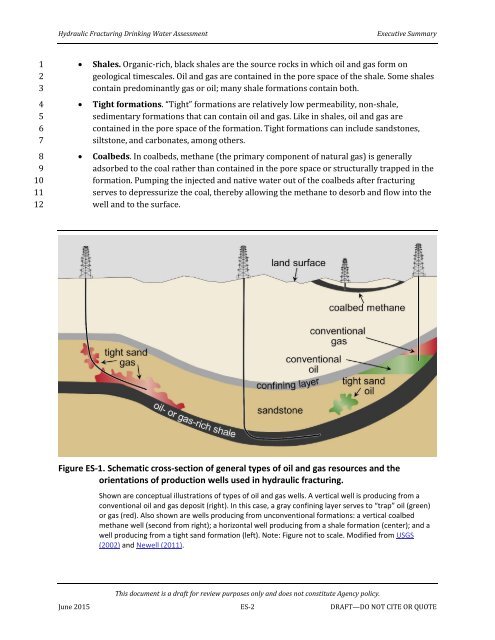Assessment of the Potential Impacts of Hydraulic Fracturing for Oil and Gas on Drinking Water Resources
Document From TamilRi.com
Document From TamilRi.com
You also want an ePaper? Increase the reach of your titles
YUMPU automatically turns print PDFs into web optimized ePapers that Google loves.
<str<strong>on</strong>g>Hydraulic</str<strong>on</strong>g> <str<strong>on</strong>g>Fracturing</str<strong>on</strong>g> <strong>Drinking</strong> <strong>Water</strong> <str<strong>on</strong>g>Assessment</str<strong>on</strong>g><br />
Executive Summary<br />
1<br />
2<br />
3<br />
4<br />
5<br />
6<br />
7<br />
8<br />
9<br />
10<br />
11<br />
12<br />
• Shales. Organic-rich, black shales are <str<strong>on</strong>g>the</str<strong>on</strong>g> source rocks in which oil <str<strong>on</strong>g>and</str<strong>on</strong>g> gas <str<strong>on</strong>g>for</str<strong>on</strong>g>m <strong>on</strong><br />
geological timescales. <str<strong>on</strong>g>Oil</str<strong>on</strong>g> <str<strong>on</strong>g>and</str<strong>on</strong>g> gas are c<strong>on</strong>tained in <str<strong>on</strong>g>the</str<strong>on</strong>g> pore space <str<strong>on</strong>g>of</str<strong>on</strong>g> <str<strong>on</strong>g>the</str<strong>on</strong>g> shale. Some shales<br />
c<strong>on</strong>tain predominantly gas or oil; many shale <str<strong>on</strong>g>for</str<strong>on</strong>g>mati<strong>on</strong>s c<strong>on</strong>tain both.<br />
• Tight <str<strong>on</strong>g>for</str<strong>on</strong>g>mati<strong>on</strong>s. “Tight” <str<strong>on</strong>g>for</str<strong>on</strong>g>mati<strong>on</strong>s are relatively low permeability, n<strong>on</strong>-shale,<br />
sedimentary <str<strong>on</strong>g>for</str<strong>on</strong>g>mati<strong>on</strong>s that can c<strong>on</strong>tain oil <str<strong>on</strong>g>and</str<strong>on</strong>g> gas. Like in shales, oil <str<strong>on</strong>g>and</str<strong>on</strong>g> gas are<br />
c<strong>on</strong>tained in <str<strong>on</strong>g>the</str<strong>on</strong>g> pore space <str<strong>on</strong>g>of</str<strong>on</strong>g> <str<strong>on</strong>g>the</str<strong>on</strong>g> <str<strong>on</strong>g>for</str<strong>on</strong>g>mati<strong>on</strong>. Tight <str<strong>on</strong>g>for</str<strong>on</strong>g>mati<strong>on</strong>s can include s<str<strong>on</strong>g>and</str<strong>on</strong>g>st<strong>on</strong>es,<br />
siltst<strong>on</strong>e, <str<strong>on</strong>g>and</str<strong>on</strong>g> carb<strong>on</strong>ates, am<strong>on</strong>g o<str<strong>on</strong>g>the</str<strong>on</strong>g>rs.<br />
• Coalbeds. In coalbeds, methane (<str<strong>on</strong>g>the</str<strong>on</strong>g> primary comp<strong>on</strong>ent <str<strong>on</strong>g>of</str<strong>on</strong>g> natural gas) is generally<br />
adsorbed to <str<strong>on</strong>g>the</str<strong>on</strong>g> coal ra<str<strong>on</strong>g>the</str<strong>on</strong>g>r than c<strong>on</strong>tained in <str<strong>on</strong>g>the</str<strong>on</strong>g> pore space or structurally trapped in <str<strong>on</strong>g>the</str<strong>on</strong>g><br />
<str<strong>on</strong>g>for</str<strong>on</strong>g>mati<strong>on</strong>. Pumping <str<strong>on</strong>g>the</str<strong>on</strong>g> injected <str<strong>on</strong>g>and</str<strong>on</strong>g> native water out <str<strong>on</strong>g>of</str<strong>on</strong>g> <str<strong>on</strong>g>the</str<strong>on</strong>g> coalbeds after fracturing<br />
serves to depressurize <str<strong>on</strong>g>the</str<strong>on</strong>g> coal, <str<strong>on</strong>g>the</str<strong>on</strong>g>reby allowing <str<strong>on</strong>g>the</str<strong>on</strong>g> methane to desorb <str<strong>on</strong>g>and</str<strong>on</strong>g> flow into <str<strong>on</strong>g>the</str<strong>on</strong>g><br />
well <str<strong>on</strong>g>and</str<strong>on</strong>g> to <str<strong>on</strong>g>the</str<strong>on</strong>g> surface.<br />
Figure ES-1. Schematic cross-secti<strong>on</strong> <str<strong>on</strong>g>of</str<strong>on</strong>g> general types <str<strong>on</strong>g>of</str<strong>on</strong>g> oil <str<strong>on</strong>g>and</str<strong>on</strong>g> gas resources <str<strong>on</strong>g>and</str<strong>on</strong>g> <str<strong>on</strong>g>the</str<strong>on</strong>g><br />
orientati<strong>on</strong>s <str<strong>on</strong>g>of</str<strong>on</strong>g> producti<strong>on</strong> wells used in hydraulic fracturing.<br />
Shown are c<strong>on</strong>ceptual illustrati<strong>on</strong>s <str<strong>on</strong>g>of</str<strong>on</strong>g> types <str<strong>on</strong>g>of</str<strong>on</strong>g> oil <str<strong>on</strong>g>and</str<strong>on</strong>g> gas wells. A vertical well is producing from a<br />
c<strong>on</strong>venti<strong>on</strong>al oil <str<strong>on</strong>g>and</str<strong>on</strong>g> gas deposit (right). In this case, a gray c<strong>on</strong>fining layer serves to “trap” oil (green)<br />
or gas (red). Also shown are wells producing from unc<strong>on</strong>venti<strong>on</strong>al <str<strong>on</strong>g>for</str<strong>on</strong>g>mati<strong>on</strong>s: a vertical coalbed<br />
methane well (sec<strong>on</strong>d from right); a horiz<strong>on</strong>tal well producing from a shale <str<strong>on</strong>g>for</str<strong>on</strong>g>mati<strong>on</strong> (center); <str<strong>on</strong>g>and</str<strong>on</strong>g> a<br />
well producing from a tight s<str<strong>on</strong>g>and</str<strong>on</strong>g> <str<strong>on</strong>g>for</str<strong>on</strong>g>mati<strong>on</strong> (left). Note: Figure not to scale. Modified from USGS<br />
(2002) <str<strong>on</strong>g>and</str<strong>on</strong>g> Newell (2011).<br />
This document is a draft <str<strong>on</strong>g>for</str<strong>on</strong>g> review purposes <strong>on</strong>ly <str<strong>on</strong>g>and</str<strong>on</strong>g> does not c<strong>on</strong>stitute Agency policy.<br />
June 2015 ES-2 DRAFT—DO NOT CITE OR QUOTE

















